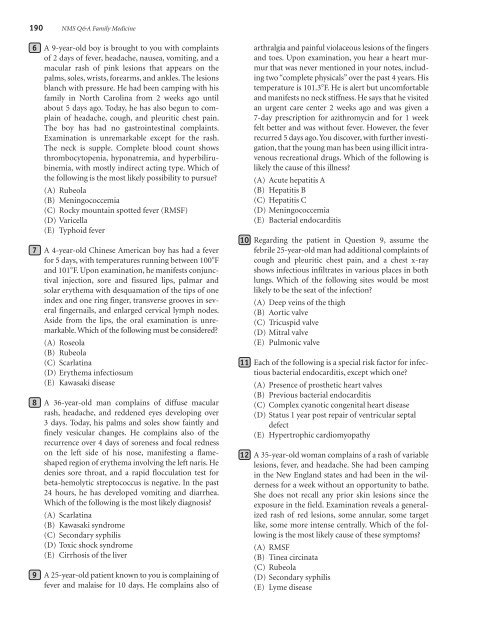NMS Q&A Family Medicine
NMS Q&A Family Medicine
NMS Q&A Family Medicine
- No tags were found...
You also want an ePaper? Increase the reach of your titles
YUMPU automatically turns print PDFs into web optimized ePapers that Google loves.
190 <strong>NMS</strong> Q&A <strong>Family</strong> <strong>Medicine</strong>6 A 9-year-old boy is brought to you with complaintsof 2 days of fever, headache, nausea, vomiting, and amacular rash of pink lesions that appears on thepalms, soles, wrists, forearms, and ankles. The lesionsblanch with pressure. He had been camping with hisfamily in North Carolina from 2 weeks ago untilabout 5 days ago. Today, he has also begun to complainof headache, cough, and pleuritic chest pain.The boy has had no gastrointestinal complaints.Examination is unremarkable except for the rash.The neck is supple. Complete blood count showsthrombocytopenia, hyponatremia, and hyperbilirubinemia,with mostly indirect acting type. Which ofthe following is the most likely possibility to pursue?(A) Rubeola(B) Meningococcemia(C) Rocky mountain spotted fever (RMSF)(D) Varicella(E) Typhoid fever7 A 4-year-old Chinese American boy has had a feverfor 5 days, with temperatures running between 100 Fand 101 F. Upon examination, he manifests conjunctivalinjection, sore and fissured lips, palmar andsolar erythema with desquamation of the tips of oneindex and one ring finger, transverse grooves in severalfingernails, and enlarged cervical lymph nodes.Aside from the lips, the oral examination is unremarkable.Which of the following must be considered?(A) Roseola(B) Rubeola(C) Scarlatina(D) Erythema infectiosum(E) Kawasaki disease8 A 36-year-old man complains of diffuse macularrash, headache, and reddened eyes developing over3 days. Today, his palms and soles show faintly andfinely vesicular changes. He complains also of therecurrence over 4 days of soreness and focal rednesson the left side of his nose, manifesting a flameshapedregion of erythema involving the left naris. Hedenies sore throat, and a rapid flocculation test forbeta-hemolytic streptococcus is negative. In the past24 hours, he has developed vomiting and diarrhea.Which of the following is the most likely diagnosis?(A) Scarlatina(B) Kawasaki syndrome(C) Secondary syphilis(D) Toxic shock syndrome(E) Cirrhosis of the liver9 A 25-year-old patient known to you is complaining offever and malaise for 10 days. He complains also ofarthralgia and painful violaceous lesions of the fingersand toes. Upon examination, you hear a heart murmurthat was never mentioned in your notes, includingtwo “complete physicals” over the past 4 years. Histemperature is 101.3 F. He is alert but uncomfortableand manifests no neck stiffness. He says that he visitedan urgent care center 2 weeks ago and was given a7-day prescription for azithromycin and for 1 weekfelt better and was without fever. However, the feverrecurred 5 days ago. You discover, with further investigation,that the young man has been using illicit intravenousrecreational drugs. Which of the following islikely the cause of this illness?(A) Acute hepatitis A(B) Hepatitis B(C) Hepatitis C(D) Meningococcemia(E) Bacterial endocarditis10 Regarding the patient in Question 9, assume thefebrile 25-year-old man had additional complaints ofcough and pleuritic chest pain, and a chest x-rayshows infectious infiltrates in various places in bothlungs. Which of the following sites would be mostlikely to be the seat of the infection?(A) Deep veins of the thigh(B) Aortic valve(C) Tricuspid valve(D) Mitral valve(E) Pulmonic valve11 Each of the following is a special risk factor for infectiousbacterial endocarditis, except which one?(A) Presence of prosthetic heart valves(B) Previous bacterial endocarditis(C) Complex cyanotic congenital heart disease(D) Status 1 year post repair of ventricular septaldefect(E) Hypertrophic cardiomyopathy12 A 35-year-old woman complains of a rash of variablelesions, fever, and headache. She had been campingin the New England states and had been in the wildernessfor a week without an opportunity to bathe.She does not recall any prior skin lesions since theexposure in the field. Examination reveals a generalizedrash of red lesions, some annular, some targetlike, some more intense centrally. Which of the followingis the most likely cause of these symptoms?(A) RMSF(B) Tinea circinata(C) Rubeola(D) Secondary syphilis(E) Lyme disease
















